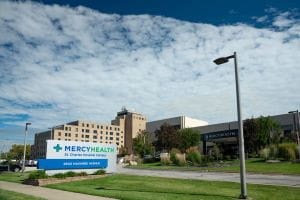Rotations and Curriculum — Emergency Medicine Residency at St. Vincent Medical Center
Facilities
|
Mercy Health – St. Vincent Medical Center St. Vincent is home to four Life Flight air ambulances, holds the highest designation for treating high-risk mothers and babies, includes a comprehensive stroke center and is a Level I Trauma Center for adults and Pediatric Level II. It is also the only burn center in Toledo. Located on the St. Vincent campus are: Orthopedics, Mercy Health Regional Heart and Vascular Institute, Mercy Health Neuroscience Institute and the area’s only Mobile Stroke Unit. St. Vincent provides a modern, attractive and secure campus and takes a leadership role in providing quality medical education and community development. |
 |
|
|
Nationwide Children's Hospital – Toledo Our emergency department volume is more than 66,000 patients. St. Vincent is also home to Nationwide Children’s Hospital – Toledo, which helps care for our tiniest of patients. We are an accredited stroke center. Our residents have the opportunity to see a variety of both common and complex pathology. Senior residents have the option of participating in an aeromedicine curriculum starting in their second year of residency serving as the primary flight physicians for the Life Flight/Mobile Life Critical Care Transportation Network. |
|
Life Flight Network Mercy Health – St. Vincent Medical Center and St. Rita’s Medical Center form the Mercy Health Life Flight Network. This network provides air and ground transportation to the critically injured through operations of four air medical helicopters, four mobile intensive care units and more than 150 employees making a difference in lives every day. We provide services to medical facilities and communities located throughout southwest, northwest and northeast Ohio and southeast Michigan. |
 |

|
Mercy Health – St. Charles Hospital St. Charles Hospital is the location of our rural/community emergency medicine experience. St. Charles has been providing for the healthcare needs of Toledo’s eastern communities. A 390-bed Level III Trauma Center, serving residents of Oregon and East Toledo Lucas, Wood and Ottawa counties. |
Rotation Schedule
The Emergency Medicine Residency Program at St. Vincent Medical Center utilizes a 13-block academic schedule. The intent of this program is to train within the framework of ABMS and ACGME guidelines to optimize each resident’s ability to achieve excellence in emergency medicine.
|
PGY 1 Rotation |
Blocks |
| Orientation | 1 block |
|
Emergency Medicine |
3 blocks |
|
Pediatric Emergency Medicine |
1 block |
| Pediatric EMS | 1 block |
|
Trauma Floor |
2 blocks |
|
Medical ICU |
1 block |
|
Observation Unit |
1 block |
|
Pediatric ICU |
1 block |
|
Anesthesia/Ultrasound |
1 block |
|
Obstetrics |
1 block |
|
PGY 2 Rotation |
Blocks |
|
Emergency Medicine |
5 blocks |
| Emergency Department* | 1 block |
|
Emergency Medicine |
1 block |
|
Pediatric Emergency Medicine |
1 block |
|
EMS |
1 block |
|
Medical ICU |
1 block |
|
Trauma Surgical ICU |
1 block |
|
Neurocritical Care |
1 block |
*Selective rotation – interventional radiology vascular access. This includes a number of shifts each in the emergency department, interventional radiology department and circulation with the intravenous access team.
|
PGY 3 Rotation |
Blocks |
|
Emergency Medicine |
9 blocks |
|
Pediatric Emergency Medicine/Teaching |
1 block |
|
Elective |
1 block |
|
ED/Combo |
1 block |
|
Medical ICU |
1 block |
Out-of-house moonlighting is available and encouraged by the program during PGY-3 year (for eligible residents).
Didactic Curriculum
Supplemental to clinical curriculum the program offers a formal didactic series:
- Weekly Grand Rounds occurs on Wednesday mornings and provides five hours of protected lecture time from 7:30 a.m. to 12:30 p.m. Grand Rounds usually consists of lectures and presentations from residents, faculty, staff and guest lecturers. A mix of case presentations, lectures, X-ray and ECG readings, medicolegal review and lively, interactive discussion keep the mornings from becoming boring. The fifth Wednesday of a month, residents participate in off-campus team building events.
- Monthly Journal Club is also held during Grand Rounds. Each month our research director, Dr. Plewa, assigns resident articles and facilitates discussion and critical evaluation. A few times a year, articles are selected focusing primarily on Pediatrics. Journal Club is an informal way to remain current in the literature and to learn to critically evaluate published studies.
- Trauma Lab is another asset for our emergency medicine residents. An attending directly supervises while residents perform procedures such as intraosseous access, diagnostic peritoneal lavage, transvenous pacing, chest tube placement, emergent thoracotomy, cardiograph, cricothyroidotomy, retrograde intubations and more. This is a great opportunity to improve your procedural skills.
- Once-a-month simulation training is also provided to enhance the residents’ skills on certain procedures for care of critically ill patients, obstetrics care and cardiac arrest cases. There are specific simulation goals for each program year. This program has dedicated faculty and weekly hours to give residents an opportunity to demonstrate what they have learned and a chance to teach medical students.
- Oral board simulations provide good practice for the third-year residents and an opportunity for PGY-1 and PGY-2 residents to observe a mock exam case. Once a month, an attending will present a simulated oral board exam case to a PGY-3 resident during Grand Rounds. This nerve-wracking experience is incredibly helpful for learning.
- Monthly exams are administered periodically using web-based question banks. This provides a great preparation for the annual in-service exam as well as for the emergency medicine written boards.
- Online emergency medicine education and board preparation is provided and utilized throughout training from multiple sources, including: ACEP/EMRA, ROSH Review, EMRap, EMsono, Hippo EM and ECG Weekly.

